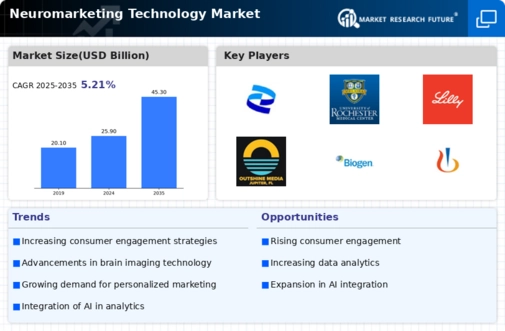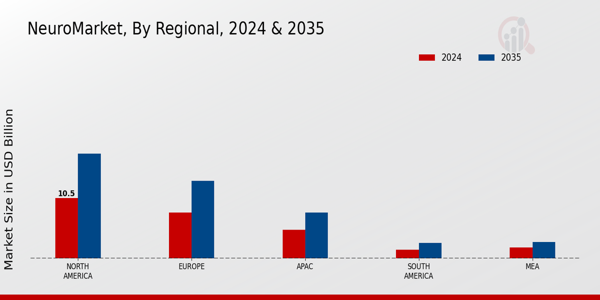Market Growth Projections
The Global Neuromarketing Technology Market Industry is projected to experience robust growth in the coming years. With a market value of 25.9 USD Billion in 2024, the industry is expected to expand significantly, reaching an estimated 45.3 USD Billion by 2035. This growth trajectory indicates a compound annual growth rate (CAGR) of 5.21% from 2025 to 2035. Such projections suggest a strong demand for neuromarketing technologies as businesses increasingly seek to leverage scientific insights to enhance their marketing strategies. The anticipated growth reflects a broader trend towards data-driven decision-making in marketing, highlighting the importance of understanding consumer behavior.
Advancements in Neuroimaging Techniques
Advancements in neuroimaging techniques significantly influence the Global Neuromarketing Technology Market Industry. Technologies such as functional magnetic resonance imaging (fMRI) and electroencephalography (EEG) have evolved, allowing for more precise and comprehensive analysis of consumer brain activity. These innovations enable marketers to understand emotional responses and cognitive processes associated with brand interactions. As a result, companies can optimize their advertising strategies based on real-time data. The continuous improvement in these technologies is expected to drive market growth, with an anticipated increase in market value to 45.3 USD Billion by 2035, reflecting a growing reliance on scientific insights in marketing.
Growing Focus on Consumer Behavior Analysis
The Global Neuromarketing Technology Market Industry is propelled by a growing focus on consumer behavior analysis. Businesses are increasingly investing in understanding the psychological and emotional factors that influence purchasing decisions. Neuromarketing tools provide valuable insights into consumer preferences, enabling brands to refine their marketing strategies. This emphasis on data-driven decision-making is likely to enhance the effectiveness of marketing campaigns, leading to higher conversion rates. As organizations seek to leverage these insights, the market is projected to grow at a CAGR of 5.21% from 2025 to 2035, indicating a sustained interest in understanding consumer behavior through advanced technologies.
Increasing Demand for Personalized Marketing
The Global Neuromarketing Technology Market Industry experiences a notable surge in demand for personalized marketing strategies. Companies increasingly recognize the importance of tailoring their marketing efforts to individual consumer preferences and behaviors. Neuromarketing technologies, such as EEG and fMRI, provide insights into consumer decision-making processes, enabling brands to create more effective campaigns. This trend is expected to contribute to the market's growth, with projections indicating a market value of 25.9 USD Billion in 2024. As businesses strive to enhance customer engagement and satisfaction, the adoption of neuromarketing tools is likely to become more prevalent.
Integration of Artificial Intelligence in Marketing
The integration of artificial intelligence (AI) into marketing strategies plays a crucial role in shaping the Global Neuromarketing Technology Market Industry. AI technologies enhance the capabilities of neuromarketing tools by enabling more sophisticated data analysis and predictive modeling. This integration allows marketers to identify patterns in consumer behavior and tailor their approaches accordingly. As AI continues to evolve, its application in neuromarketing is expected to expand, leading to more effective and targeted marketing campaigns. The synergy between AI and neuromarketing technologies is likely to contribute to the overall growth of the market, fostering innovation and efficiency in marketing practices.
Rising Adoption of Neuromarketing in Various Industries
The rising adoption of neuromarketing across various industries significantly impacts the Global Neuromarketing Technology Market Industry. Sectors such as retail, healthcare, and entertainment are increasingly utilizing neuromarketing techniques to enhance customer experiences and improve product offerings. For instance, retailers leverage neuromarketing insights to optimize store layouts and product placements, ultimately driving sales. This trend reflects a broader recognition of the value of understanding consumer psychology in diverse contexts. As more industries embrace these technologies, the market is poised for substantial growth, with projections indicating a market value of 25.9 USD Billion in 2024.





















